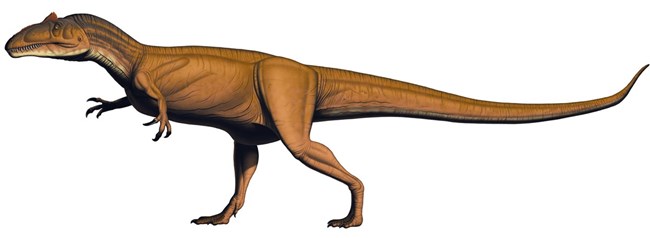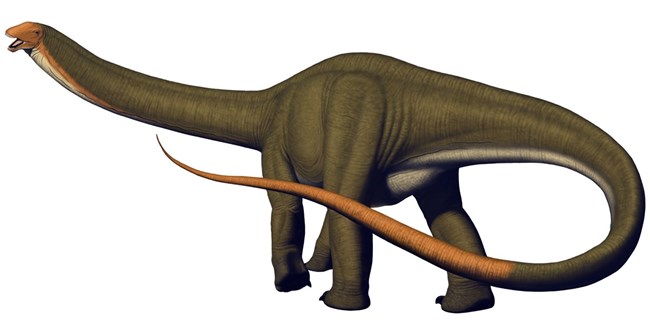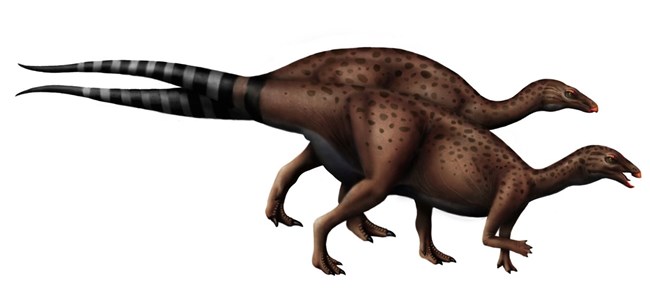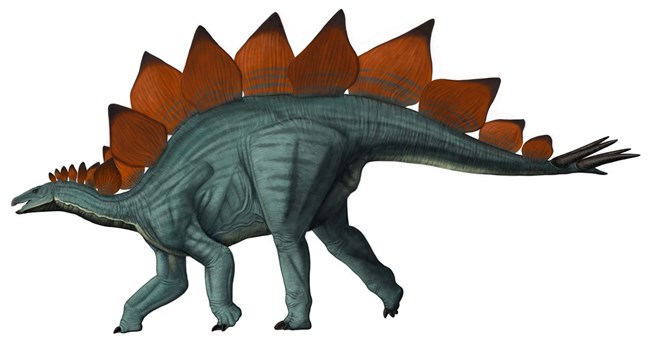Introduction
Dinosaurs (leaving out the birds) evolved into many different groups over their roughly 170 million year existence, from approximately 235 million years ago to 66 million years ago. The first true dinosaur was probably a small, bipedal animal of carnivorous or omnivorous diet, similar to Eoraptor from Argentina. The earliest true dinosaur fossils date to the early part of the Late Triassic, but it is very unlikely that we have found the actual very first dinosaurs, and the group probably originated in the Middle Triassic or Early Triassic.
We have a general picture of the closest relatives to dinosaurs. The closest major group to dinosaurs appears to be the flying pterosaurs. In a wider sense, dinosaurs belong to a group called Archosauria. Archosaurs, the “ruling reptiles”, are today represented by crocodilians and birds. Therefore, when paleontologists want to think about aspects of dinosaurs that didn’t fossilize, like behavior and soft tissues, they can consider birds, which are living dinosaurs, and crocodilians, which are their next-closest relatives. The only problem is that many dinosaurs likely had lifestyles and anatomies that were nothing like either modern crocodiles or birds, but these comparisons can at least narrow down the possibilities.
Dinosauria
Historically, dinosaurs have been divided into saurischians (“lizard-hipped”) and ornithischians (“bird-hipped”), based on the arrangement of their hip bones. In saurischians, the two lower bones of the hip point away from each other, as in lizards; and in ornithischians, the two lower hip bones both point backwards, as in birds. (Ironically, birds by ancestry are saurischians rather than ornithischians—their evolution of true “bird hips” occurred after the saurischian–ornithischian split.) The saurischians are divided into theropods and sauropodomorphs. Theropods are the classic bipedal carnivorous dinosaurs, from Coelophysis to Tyrannosaurus, and also include birds. Sauropodomorphs include the enormous quadrupedal, herbivorous long-necked, long-tailed sauropods (Brachiosaurus, Diplodocus) and their cousins the “prosauropods”. Finally, the ornithischians are harder to define because they include several very different groups, but all ornithischians share a special “beak bone” (the predentary) at the tip of the lower jaw.
Theropods

NPS illustration by Bob Walters Tess Kissinger.
Theropods began as small hunters along the lines of Coelophysis, with long, slender bodies. Some of them evolved into large species early on, and one of these early groups eventually produced the abelisaurs, the major theropods of Southern Hemisphere continents in the Cretaceous. The horned Ceratosaurus is a relative of these theropods. Another lineage, the carnosaurs, were the major theropods of the Late Jurassic and Early Cretaceous. The most famous member of this group is Allosaurus. Carnosaurs became much rarer in the Late Cretaceous after producing giants like Carcharodontosaurus and Giganotosaurus. The unusual spinosaurs, also prominent in the middle part of the Cretaceous, are part of a group that split off after the ceratosaurs but before the carnosaurs.
Coelurosaurs
At the same time the carnosaurs were the major large theropods, another group, the coelurosaurs, was diversifying as much smaller theropods. Jurassic coelurosaurs are not known well because of their small size and thin-walled hollow bones, but we know that they divided into several lineages during the Jurassic that further split and rose to prominence during the Cretaceous:
-
Alvarezsauroidea: Small, lightly built theropods with hands and arms reduced to single large claws. (For reference, “small” is less than about 10 feet long, “medium” is less than about 20 feet long, and “large” is more than 20 feet long.)
-
Avialae: Birds and their closest relatives.
-
Deinonychosauria: Small to medium-sized theropods with “killer claws” on the second toe. Early deinonychosaurs and early avialans are often difficult to distinguish.
-
Ornithomimosauria: “Ostrich mimics”, mostly toothless and probably primarily herbivorous to omnivorous, generally small to medium-sized.
-
Oviraptorosauria: Generally small to medium-sized theropods with diverse head shapes (usually toothless and often crested) and hands, probably filling a variety of niches.
-
Therizinosauria: Something like dinosaurian sloths with long tails and long necks with small heads, these are thought to have been herbivores, generally medium to large.
-
Tyrannosauroidea: this group includes the tyrannosaurids and their close cousins, some of which lived in the American West as small predators at the same time as Allosaurus. Of course, they are most famous for Tyrannosaurus rex.
Sauropods

NPS illustration by Bob Walters and Tess Kissinger.
Sauropodomorphs began as small bipedal omnivores or carnivores, but soon shifted to herbivory and started evolving large body sizes. The well-known Plateosaurus, for example, could reach more than 30 feet long and four tons, well before the end of the Triassic. These Triassic “prosauropods” already had the typical sauropodomorph long neck with small head, long tail, and bulky body, but few of them could yet walk on all four feet. The first true sauropods had this ability, which must have helped later sauropods attain such large sizes (it’s a lot easier to be 75 feet long and 20 tons when all of your feet are on the ground!).
Sauropods became the largest land animals ever known during the Jurassic. Their bones have been found on every continent. They were especially abundant toward the end of the Jurassic; great boneyards of sauropod fossils have been found in China, Tanzania, and the United States (such as Dinosaur National Monument). The first groups of sauropods tended to have almond-shaped teeth and boxy heads, and some had exceptionally long necks. Sauropods split into two main groups during the Jurassic. One group, the macronarians, kept the broader teeth, at least for a while. Famous Jurassic macronarians include Brachiosaurus and Camarasaurus. The other group, the diplodocoids, evolved pencil-like teeth and long, low bodies. Famous diplodocoids include Apatosaurus, Brontosaurus, and Diplodocus.
Sauropods seem to have been reduced going into the Early Cretaceous. Most groups went extinct by the middle of the Cretaceous, to be replaced by a group of macronarians known as the titanosaurs. The titanosaurs evolved stocky broad bodies and pencil-like teeth, and most species had one or more bony lumps possibly for mineral storage. Titanosaurs spread to all of the continents before the end of the Cretaceous. It seems like something happened in North America, though, because sauropod fossils are missing for most of the Late Cretaceous until the appearance of the titanosaur Alamosaurus in the southwestern United States near the end of the period (see Big Bend National Park).
Ornithischians

NPS illustration by Bob Walters and Tess Kissinger.
The beginnings of the third and last main group of dinosaurs, the ornithischians, are poorly known. Some scientists think that a Triassic group known as Silesauridae (quadrupedal beaked animals) are actually early ornithischians instead of dinosaur cousins, but this is controversial. The ornithischians split into several very distinct groups during the Jurassic. Most of these became prominent during the Cretaceous. Most ornithischians can be placed in one of five groups: Ankylosauria (armored dinosaurs), Ceratopsia (horned dinosaurs), Ornithopoda, Pachycephalosauria (bone-headed dinosaurs), and Stegosauria (plated dinosaurs).
-
Ankylosaurs were squat quadrupeds with pieces of bony armor (osteoderms) covering their upper surfaces and part of their sides. Some of these osteoderms were enlarged into plates or spikes. One subgroup of ankylosaurs, the ankylosaurids, had bony tail clubs.
-
Ceratopsians are known as horned dinosaurs, but many early forms did not have horns (such as Psittacosaurus and Protoceratops). All ceratopsians had an extra beak bone (the rostral) at the front of the upper jaw, though, giving them parrot-like beaks. Ceratopsians flourished in the Late Cretaceous, evolving into enormous animals such as Triceratops with broad bony frills, long brow horns, and powerful shearing jaws.
-
Ornithopods began as small bipedal herbivorous dinosaurs, but some soon began to grow much larger, such as Camptosaurus. By the middle of the Cretaceous, the largest ornithopods, such as Iguanodon, were more than 30 feet long and switched between two legs and four legs. During the Late Cretaceous one branch evolved into the hadrosaurs, the famous “duck-billed dinosaurs”. Hadrosaurs actually weren’t very similar to ducks except for some having broad bills; they were land animals and had powerful arrangements of hundreds of stacked teeth. Many had elaborate crests.
-
Pachycephalosaurs are the least known of the five groups. (In fact, we’ve never found a pachycephalosaur's hand.) They seem to have been small to medium-sized herbivorous bipeds, and are best known from the Late Cretaceous of Asia and North America. They are most famous for their thickened skulls, often exaggerated into a dome shape, sometimes with bony nodes and spikes.

NPS illustration by Bob Walters and Tess Kissinger.
- Stegosaurs were among the first ornithischians to spread widely, spreading during the Jurassic. Stegosaurus is noted for its large bony plates, but most stegosaurs had spikes or spike-like plates rather than large plates along their backs. Stegosaurs also had pairs of spikes at the ends of their tails. Stegosaurs dwindled in the Cretaceous and appear to have gone extinct before the end of the period.
Site Index and Credits
Age of Dinosaurs (2021)
Text by Justin Tweet (AGI). Contributors: Vincent Santucci (GRD), Adam Marsh (PEFO), ReBecca Hunt-Foster (DINO), Don Corrick (BIBE). Project Lead / Web Development, Jim Wood (GRD).
References
-
Tweet, J.S. and V.L. Santucci. 2018. An Inventory of Non-Avian Dinosaurs from National Park Service Areas. in Lucas, S.G. and Sullivan, R.M., (eds.), Fossil Record 6. New Mexico Museum of Natural History and Science Bulletin 79: 703-730. https://irma.nps.gov/DataStore/Reference/Profile/2257153
-
Santucci, V.L., A. Marsh, W. Parker, D. Chure, and D. Corrick, 2018. “Age of Reptiles”: Uncovering the Mesozoic Fossil Record in three Intermountain national parks. IMR Crossroads. Spring 2018, p. 4-11. https://irma.nps.gov/DataStore/Reference/Profile/2253529
Last updated: July 8, 2022
